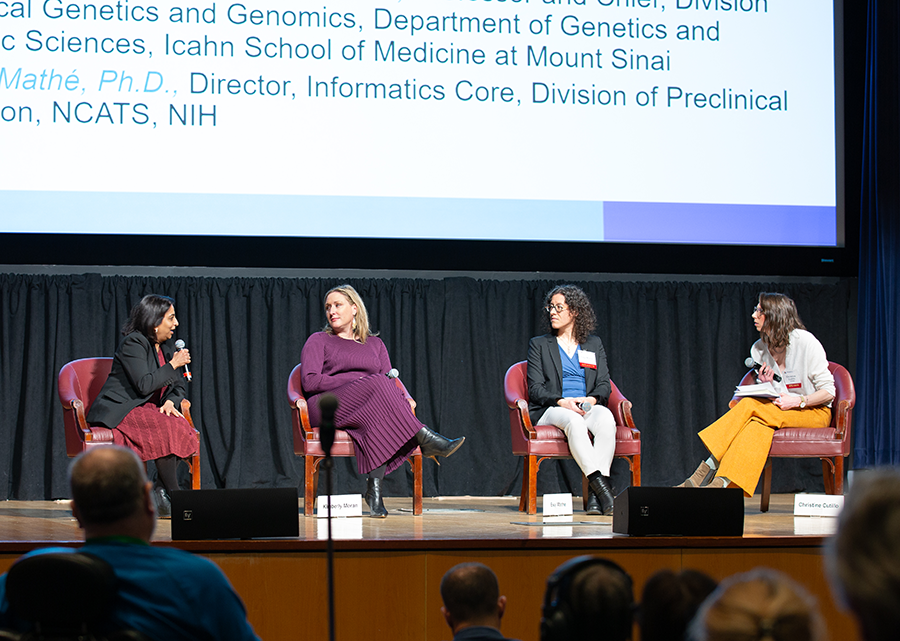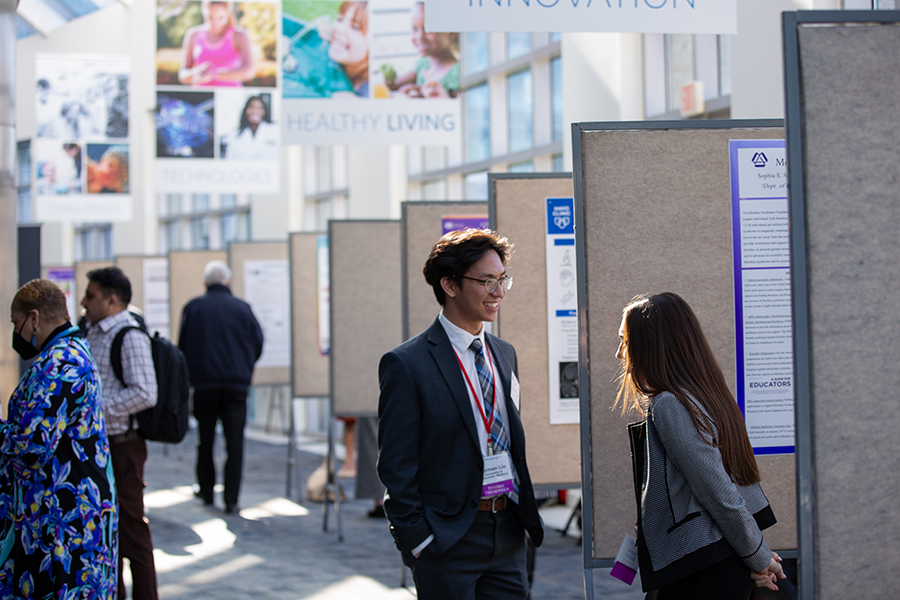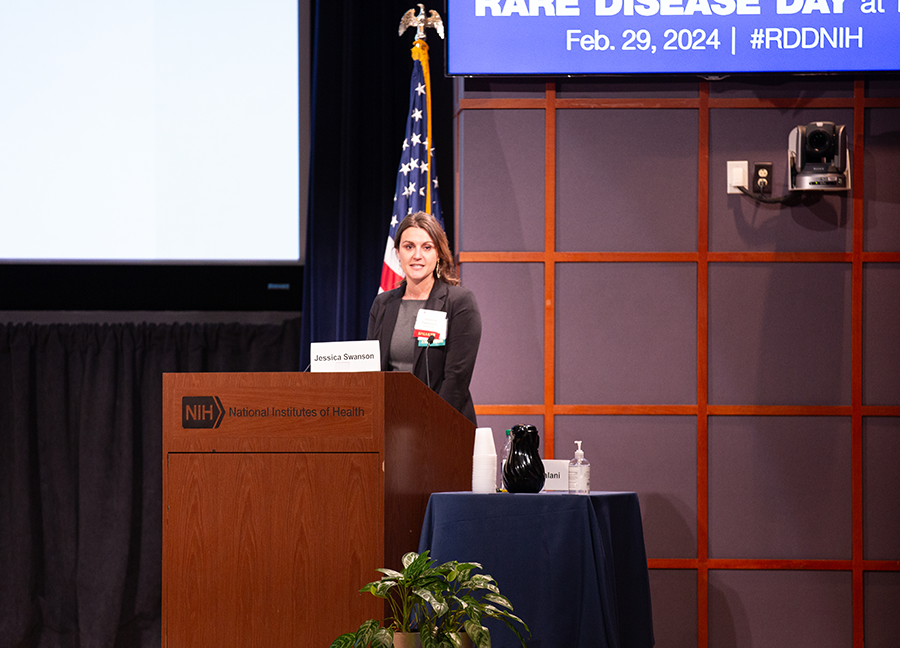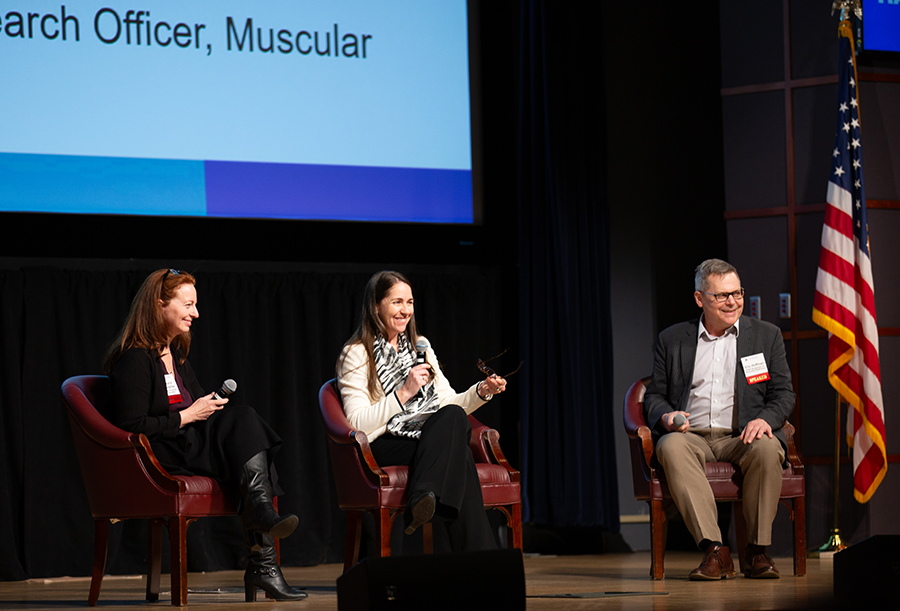Rare Disease Day at NIH 2024: Showcasing Voices and New Opportunities
April 23, 2024
On Feb. 29, 2024 — the rarest day of the year — patients, clinicians, researchers, drug developers and advocates traveled to the NIH main campus or tuned in to NIH VideoCast for Rare Disease Day (RDD) at NIH. More than 2,000 people attended RDD at NIH. Co-sponsored by NCATS and the NIH Clinical Center, the annual event raises awareness about rare diseases and the people they affect. It also highlights NIH partnerships that advance research and new treatments. This year’s event included scientific sessions, patient stories, scientific posters and exhibits, and art and film exhibits.
NIH is working hard to address the significant and often unmet needs of those affected by rare diseases. In her remarks, NIH Director Monica M. Bertagnolli, M.D., emphasized that rare diseases span across NIH’s research portfolio.
“We at NIH believe that caring for people with rare diseases is at the heart of everything that we do,” she said.
RDD at NIH speakers addressed a wide range of topics, including the rare disease diagnostic odyssey, drug repurposing and development, gene therapy, artificial intelligence (AI), and public-private partnerships. Many of their stories highlighted NIH’s integral role in addressing rare diseases from all angles — research, therapeutic development and information sharing.

NCATS Director Joni L. Rutter, Ph.D., talking with Rare Disease Day at NIH attendees. (NCATS)
“Rare Disease Day is a day to celebrate our successes, to honor those we hold dear and honor those we’ve lost,” said NCATS Director Joni L. Rutter, Ph.D. “And today, we pause, granting ourselves the space for creativity and contemplation, so that tomorrow, we can speed up with a renewed sense of purpose.” Rutter recently published a guest NIH blog post that highlights the need to communicate about rare diseases research.
The Diagnostic Odyssey: Through the Lens of Patients and Caregivers
Dominique C. Pichard, M.D., director of the NCATS Division of Rare Diseases Research Innovation, shared the obstacles she faced in obtaining a diagnosis and treatment for her daughter, who has Rett syndrome. Pichard — a clinician and leader in rare diseases research — advocated for her daughter’s diagnosis. She had recognized that her daughter showed signs of Rett syndrome — a neurodevelopmental condition that is often marked by loss of developmental abilities between 6 and 18 months of age.
Pichard’s concerns were largely dismissed by her daughter’s physicians. “I was not seen; I was not heard,” she recounted. “But in my gut, I knew.”
Almost one year after raising concerns, Pichard finally received a diagnosis for her daughter. Her experience — known as the “diagnostic odyssey” — reflects the struggles faced by families in the rare diseases community. Patients may wait as long as 15 years to receive a correct diagnosis.
Jessica Swanson shared the challenges that her family faced in finding a diagnosis for her daughter, Isla, who began experiencing tonic-clonic seizures at age 7 months. After years without answers, Swanson turned to the Undiagnosed Diseases Network (UDN). Just before her 10th birthday, Isla was diagnosed with CDKL5-deficiency disorder.
Swanson explained that the diagnosis provided the family with a label, a community and hope for the future. She emphasized the value of building connections with other patients and families. “The absence of a diagnosis left us in a state of perpetual uncertainty, exasperating an emotional toll on our family,” Swanson recounted. “The rare disease community, however, taught us ‘rare’ does not equal ‘alone.’ And there is strength in shared experiences.”
The UDN is a research program that combines basic and clinical research to help individuals who have sought a clinical diagnosis without success — and their families — understand their health conditions. The program is supported by 17 institutes and centers at NIH, including NCATS. It is led by the National Institute of Neurological Disorders and Stroke.
Shortening the diagnostic odyssey is only part of the challenge. Helping all people with rare diseases access treatments in an equitable way is another major effort. Seema R. Lalani, M.D., spoke on Project GIVE (Genetic Inclusion by Virtual Evaluation), which is funded by NCATS. Project GIVE focuses on a community-based partnership to reduce health disparities and improve access to care for children in Texas’ Rio Grande Valley, a historically underserved region.
Project GIVE uses Consultagene, a patient referral platform that provides educational resources and genetics health care services that have helped families obtain diagnoses and begin treatments. To date, 109 patients have been enrolled in Project GIVE, and 61 families have received whole-genome sequencing results. Thus far, 17 families have received a resolved diagnosis, and 2 have received a partially resolved diagnosis.
Project GIVE is just one example of NCATS’ efforts to foster community engagement, educate providers, and help to reduce health disparities for families affected by rare diseases. During her remarks, Lalani quoted parents of children with rare diseases in the Rio Grande Valley, including this reflection: “Project GIVE gave [us] not only hope but peace of mind. We were able to finally receive a diagnosis after years of trying to find an answer … I can’t put into words how thankful we all are.”
Artificial Intelligence for Rare Diseases: Exploring New Possibilities

Manisha Balwani, M.D., M.S., FACMG; Kimberly A. Moran, Ph.D., M.B.A., CDP; Ewy A. Mathé, Ph.D.; Christine Cutillo, M.M.C.i. (NCATS)
Speakers also explored AI and its role in rare diseases research. NIH has recognized that AI can assist with data-driven discovery in various areas of biomedical research, including rare diseases. The speakers discussed ways to make AI tools more inclusive and equitable. They shared stories that demonstrated using AI to shorten the diagnostic odyssey, identify patients for clinical trials, and build tools for drug repurposing. They also discussed how to protect patient privacy and enhance data sharing.
Kimberly A. Moran, Ph.D., M.B.A., explained how she uses AI to identify patterns within groups of people with myasthenia gravis, a rare autoimmune neuromuscular disease. Insights from these data may help identify patients who have not yet received a diagnosis for this disorder. Moran explained that AI can help clinicians predict patients’ symptoms and develop personalized treatments. She also emphasized the importance of discussing AI technologies with patients.
Moran noted doctors should explain the implications and potential of patients’ sharing their data. “It’s going to take this entire community — to be educated, to be literate in terms of data and understanding the power,” she said. “We see the rare disease community willing to give their data … but this will come to be a personal choice in the future.”
AI may improve diagnoses, predict the effects of treatments, and match patients to the right treatment, explained Ewy A. Mathé, Ph.D., director of informatics in the NCATS Division of Preclinical Innovation. AI can also help researchers ask new questions to test, find new treatments, and study many diseases at once. Mathé explained how CURE ID, an AI-driven data collection tool built by NCATS and the U.S. Food and Drug Administration (FDA), can help researchers find rare disease treatments among existing drugs.
Public-Private Partnerships: Leveraging Unique Funding Models
Public-private partnerships are another key approach that NCATS uses to speed the development of treatments for rare diseases. Eric P. Hoffman, Ph.D., and Sharon Hesterlee, Ph.D., shared how a partnership between NCATS and ReveraGen BioPharma, Inc., led to FDA approval of vamorolone, a drug used to treat Duchenne muscular dystrophy (DMD).
ReveraGen’s business model for developing vamorolone used venture philanthropy partners rather than venture capital investors. ReveraGen also had a different kind of partnership with NCATS, through its Therapeutics for Rare and Neglected Diseases (TRND) program. TRND supports preclinical development of drugs to treat rare or neglected disorders. With help from the TRND program, ReveraGen demonstrated that the steroid compound VBP15 could be used to treat DMD symptoms with minimal side effects.
Hesterlee explained that the philanthropic model helped ReveraGen obtain funding for a drug that had great potential but had not captured the interest of more traditional investors.
“The community recognized that this was a need, and it was worth doing,” she said. “And so, from that sense, it really worked well to have the nonprofit investment.” Hesterlee and Hoffman emphasized that this partnership model can be used for efforts focused on other rare diseases.
Rare Diseases Research and Resources
The personal and powerful stories from RDD at NIH underscored the breadth and impact of NIH and NCATS rare diseases research and other activities. They also showcased many great research and educational resources, including those below, that the community can access any time.
- Genetic and Rare Diseases (GARD) Information Center
- Platform Vector Gene Therapy (PaVe-GT) Pilot Project
- Bespoke Gene Therapy Consortium
- Rare Diseases Registry Program (RaDaR)
- Somatic Cell Genome Editing Program
- NCATS Toolkit for Patient-Focused Therapy Development
- RARe-SOURCE





